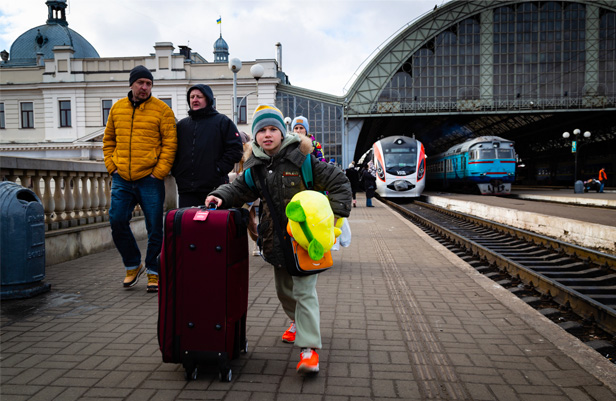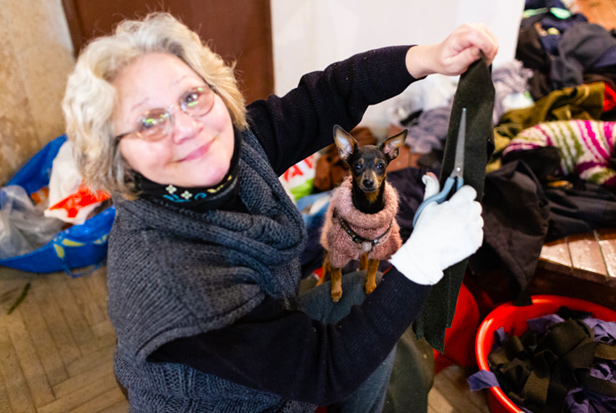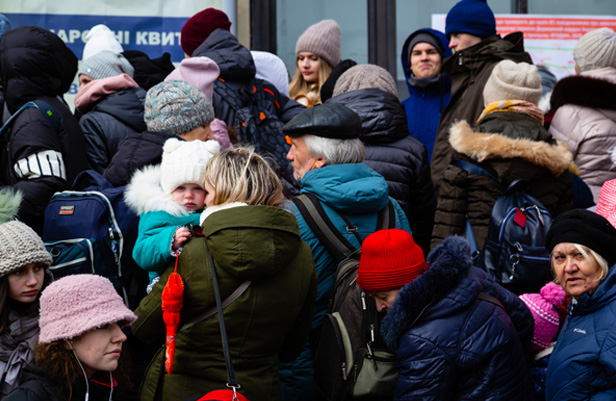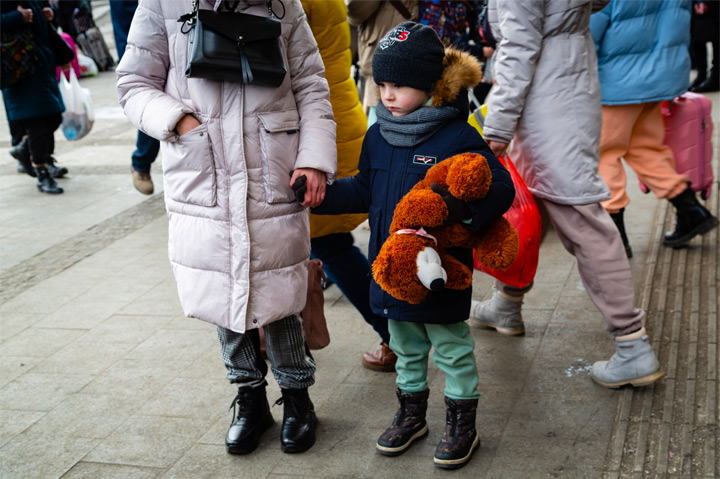March 16, 2022
ASI Technology Colleagues, Employees Continue to Fear for Safety
With the Russian military making an ever-aggressive push across Ukraine, ASI is sharing recent updates from Ukrainian technology colleagues working remotely in the war-ravaged country, along with several ASI employees in the U.S. fearful for family and friends still in their homeland. Their accounts also include photos and video from the ground.
Imagine waking to the sound of explosions. Imagine deciding what to grab as bombs rain down on your street. Imagine fleeing a war zone juggling your child on your hip.
“Imagine” is what Ukrainian President Volodymyr Zelenskyy asked the Canadian Parliament to do in an emotional address on Tuesday, pleading for them to “please close the sky” and establish a humanitarian no-fly zone to slow a brutal Russian advance. On Wednesday, March 16, in a historic virtual address to the U.S. Congress, he asked the leaders of the most powerful nation in the world to “do more” to help Ukraine during its “darkest time.”
“We need you right now,” he said. “Remember Pearl Harbor … Remember September 11 … when innocent people were attacked from the air … Is this too much to ask for a no-fly zone? … This war is not just about Ukraine. This war is about Europe and the world.”
Watch a podcast with ASI’s Nataliya Royzman and Alex Shilman discussing the impacts the Russian invasion has had on them and their friends and loved ones in Ukraine. Watch here.
After the speech, a resolute Nataliya Royzman – a Ukrainian immigrant who is now a senior financial business system analyst in ASI’s Business Applications department – said, “All his speeches are great and powerful. When he addressed European nations, they got up applauding, but did not close the airspace. I would like to see action on our side resulting from those speeches.”
For millions still living in an apocalyptic Ukraine, war, worry and fear is their new reality. (ASI’s fund drive for Ukrainian relief is ongoing; details here.) And while President Joe Biden has strongly decried Russia for its “unprovoked and unjustified attack” he stands firmly against sending U.S. soldiers to Ukraine or provoking a broader conflict with Russia with a no-fly zone.

A young refugee carrying his possessions waiting for a train to safety. (photo courtesy of Katya Moskalyuk, a friend of Vlad’s)
“They keep killing people and ruining the cities and our infrastructure, but we feel very strongly about our victory,” says Vlad, a 26-year-old ASI front-end engineer who lives in Lviv. (We’re not using his photo or last name, out of ongoing concern for his safety.) “Indeed, there is some hope for the negotiations, but as far as I know still nothing really clear.”
Vlad says Lviv, in the western part of the country on the opposite side of the worst, first bombings, is relatively stable, though Russia’s recent attack at Poland’s border 50 miles away, coupled with the tens of thousands of refugees flooding into the city, has fractured the region’s image of life-as-usual. The BBC reports there are an estimated 1.85 million internally displaced people inside Ukraine, including 200,000 alone in Lviv.

Ukrainian refugees trying to ward off the winter cold in a makeshift refugee camp in Lviv. (photo courtesy of Vlad)
“Everywhere, there are volunteer centers with many people asking for help,” says Vlad of Lviv, located not far from a larger region serving as a weapons supply route to the Ukrainian military and resistance. “Sirens are a few times per day now. The last two nights we heard it for around four hours a night so we’re a little bit more stressed since we had shelling not far from us, but in general all good. Everywhere, you should have a bag and be ready to go to a shelter or basement. But people are trying to do normal stuff so that our economy works.”

A Lviv resident helping make camouflage nets for the Ukrainian army. (photo courtesy of Katya Moskalyuk)
As for Artur, another ASI front-end engineer who lives in heavily bombed Kharkiv, “he made a multi-day trip out of Kharkiv and has found a place to stay in Southwest Ukraine,” says his supervisor Ryan Hutchison, ASI’s VP of development. Other than that, Hutchison says he has little information.
One of the most dramatic images to emerge from the war zone is a now-viral YouTube video of a Ukrainian mother in Bila Tserkva playing piano in her home after it was blasted by a Russian bomb. When ASI’s Max Stepanskiy sees such videos from his hometown, a graceful riverside city once home to beautiful churches and synagogues, he can’t believe his eyes. Citizens fleeing Russian missile strikes. Bombed out buildings. Doors blown off hinges. Giant craters, burning like portals to hell.
Stepanskiy, assistant VP of enterprise architecture and platform services, waits daily for news from Kyiv, the capital and most populous city in Ukraine that’s been under continual siege by Russian forces, where his elderly aunt and uncle, cousin and friends remain.
“They haven’t left, and my cousin has joined the community watch,” Stepanskiy says. “The enemies are trying to encircle Kyiv, so things might get worse for them in the future. They are not planning to leave the city. My friend has joined the volunteer defense and helps out at the military base that’s stationed in the city. It was bombed a couple days before he talked to me.”

A crowd of Ukrainian refugees in a train station, hoping for safe passage out. (photo courtesy of Katya Moskalyuk)
Like Stepanskiy, Royzman anxiously awaits updates from relatives in her hometown of Chernivtsi, in southwestern Ukraine.
“There is a food shortage crisis approaching them because of the disrupted supply chains, and increased demand for food because of the refugees,” Royzman says. “Chernivtsi’s normal population size is about 260,000 and they accepted over 50,000 refugees.” She also fears bombings in nearby Ivano-Frankivsk, adding, “That city is really close and had accepted as many if not more refugees.”
According to CBS News, the Russian invasion has triggered the swiftest refugee displacement crisis in Europe since World War II. A State Department spokesperson told CBS the U.S. is open to resettling Ukrainians who fled to third countries if “they cannot be protected in their current location,” but conceded it “is not a quick process.”
Says Royzman: “We are watching out for news from our [U.S.] government. Even though they say that they’re ready to accept Ukrainian refugees, they didn’t offer Ukrainians a way to apply to asylum, only for visitor’s visas. If people start arriving this way, they don’t have a legal way to work. If any of them try to change their status later to permanent residents, they’ll be technically breaking the law if they seek employment as is.”

Young refugees carry stuffed animals for comfort. (photo courtesy of Katya Moskalyuk)
Alex Shilman, senior application developer at ASI who’s also based in the U.S., has tried to keep in touch with former classmates who shared their experiences when war first broke out. Now they’ve gone quiet. “They haven’t posted any updates on their social media profiles,” he says. “Also, locals are sharing warnings not to discuss any military movements or when they hear a bombardment with anyone who contacts them.”
Shilman remains especially eager for news from Shepetivka, his Ukraine hometown. Before, friends might share news of happy occasions like weddings and graduations. Now, the news is of fear and funerals.
Ukrainians converge on a train station seeking passage to other countries. (video courtesy of a friend of Vlad’s)
“The town where I was born was not bombed yet, but it’s getting closer,” Shilman says. “The local newspaper is publishing stories of people preparing food for the ones that are fighting and also working on placement of refugees from the hot zones like Kharkiv. In the past week the city held funerals for two local soldiers who died fighting Russian occupiers.”
President Zelenskyy closed his speech to the U.S. Congress with a graphic video showing contrasting images of Ukraine and its people, happy and smiling in beautiful cities before the attack, and now, with bodies lying on the same streets. The video ended with these words on screen: “Close the sky over Ukraine.”
Please consider supporting ASI’s fund drive in collaboration with the Red Cross to benefit the Ukrainian cause. More information can be found here.